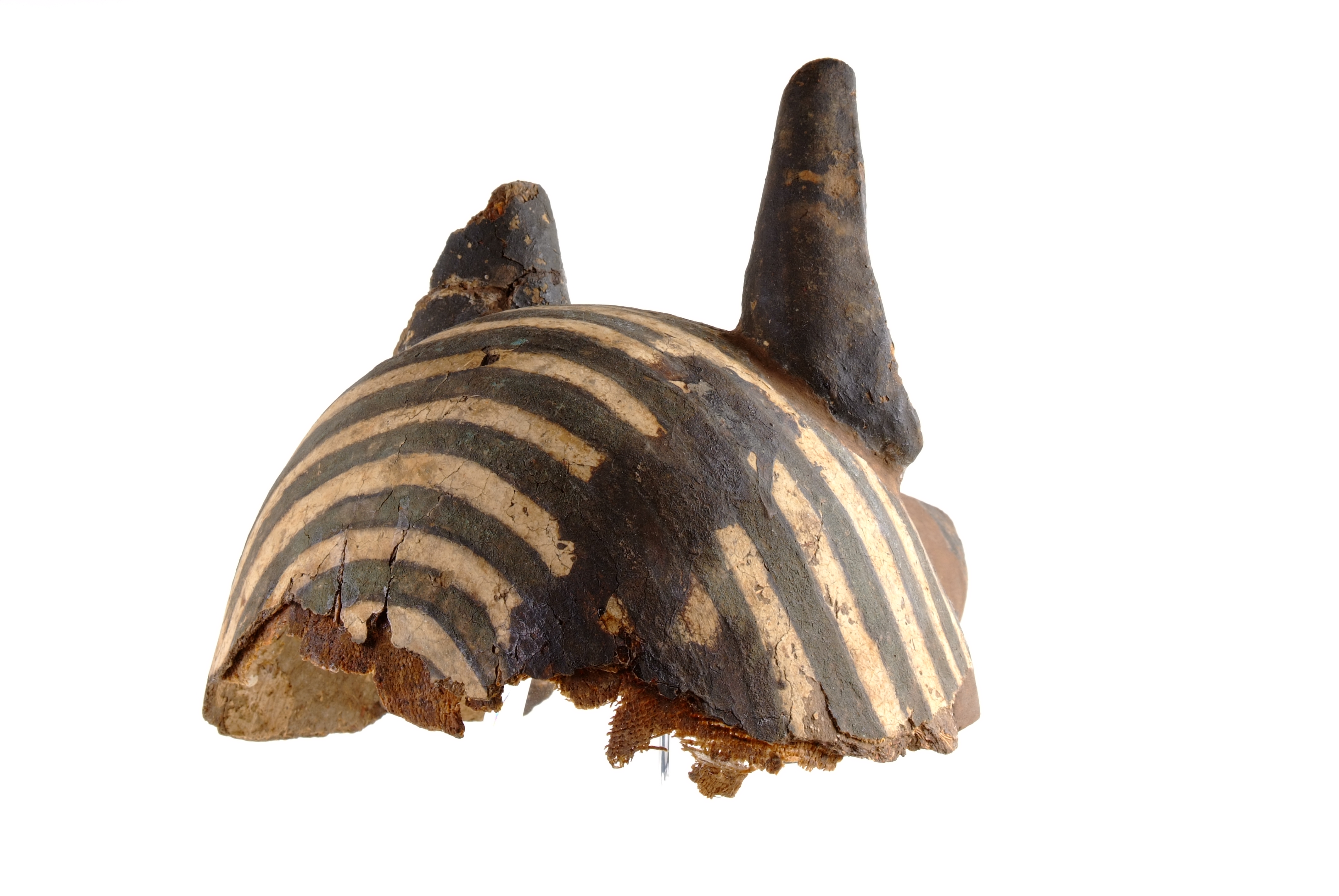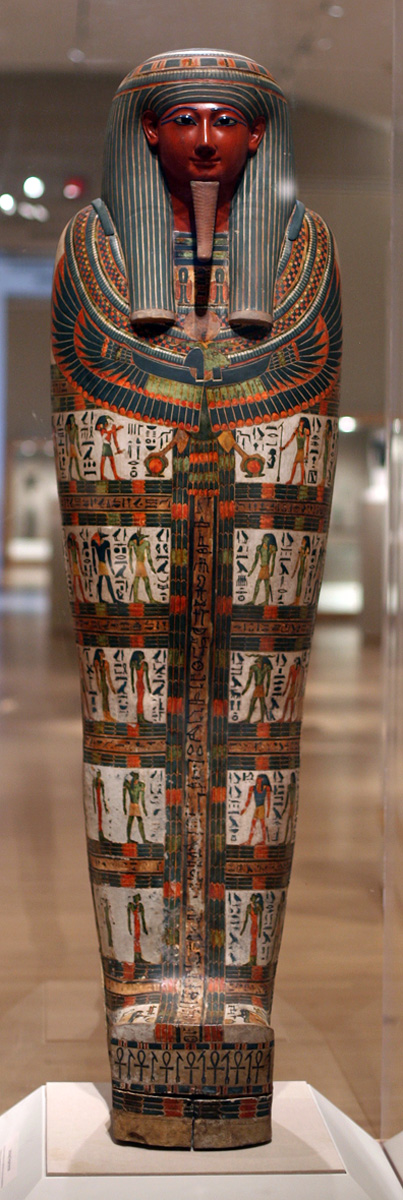Cartonnage on:
[Wikipedia]
[Google]
[Amazon]

 Cartonnage (word of French origin) is a type of material used in ancient Egyptian
Cartonnage (word of French origin) is a type of material used in ancient Egyptian New clues illuminate mysteries of ancient Egyptian portraits - Same artist painted several lifelike paintings buried with mummies
by BRUCE BOWER, published by "Society for Science & the Public" on February 14, 2016
 In a technique similar to
In a technique similar to
 The materials used to produce cartonnage changed over time. In the Middle Kingdom it was common to use plastered linen, during the
The materials used to produce cartonnage changed over time. In the Middle Kingdom it was common to use plastered linen, during the
The Walters Art Museum – Mummies and Cartonnage
Google Art Project
* Shaw, Ian; and Nicholson, Paul. ''The Dictionary of Ancient Egypt.'' p. 61. The British Museum Press, 1995.
Ancient Egyptian funerary practices Egyptology
 Cartonnage (word of French origin) is a type of material used in ancient Egyptian
Cartonnage (word of French origin) is a type of material used in ancient Egyptian funerary mask
A death mask is a likeness (typically in wax or plaster cast) of a person's face after their death, usually made by taking a cast or impression from the corpse. Death masks may be mementos of the dead, or be used for creation of portraits. It ...
s from the First Intermediate Period
The First Intermediate Period, described as a 'dark period' in ancient Egyptian history, spanned approximately 125 years, c. 2181–2055 BC, after the end of the Old Kingdom. It comprises the Seventh (although this is mostly considered spuriou ...
to the Roman
Roman or Romans most often refers to:
* Rome, the capital city of Italy
* Ancient Rome, Roman civilization from 8th century BC to 5th century AD
*Roman people, the people of ancient Rome
*''Epistle to the Romans'', shortened to ''Romans'', a lett ...
era. It was made of layers of linen
Linen () is a textile made from the fibers of the flax plant.
Linen is very strong, absorbent, and dries faster than cotton. Because of these properties, linen is comfortable to wear in hot weather and is valued for use in garments. It also ...
or papyrus
Papyrus ( ) is a material similar to thick paper that was used in ancient times as a writing surface. It was made from the pith of the papyrus plant, '' Cyperus papyrus'', a wetland sedge. ''Papyrus'' (plural: ''papyri'') can also refer to ...
covered with plaster
Plaster is a building material used for the protective or decorative coating of walls and ceilings and for moulding and casting decorative elements. In English, "plaster" usually means a material used for the interiors of buildings, while "re ...
. Some of the Fayum mummy portraits
Mummy portraits or Fayum mummy portraits are a type of naturalistic painted portrait on wooden boards attached to upper class mummies from Roman Egypt. They belong to the tradition of panel painting, one of the most highly regarded forms of art ...
are also painted on panels made of cartonnage.by BRUCE BOWER, published by "Society for Science & the Public" on February 14, 2016
Technique
 In a technique similar to
In a technique similar to papier-mâché
upright=1.3, Mardi Gras papier-mâché masks, Haiti
upright=1.3, Papier-mâché Catrinas, traditional figures for day of the dead celebrations in Mexico
Papier-mâché (, ; , literally "chewed paper") is a composite material consisting of p ...
, scraps of linen or papyrus were stuck together with plaster or resin and used to make mummy cases and masks. It could be molded to the shape of the body, forming a type of shell. After the material dried it could be painted or gilded. The shell could be decorated with geometric shapes, deities
A deity or god is a supernatural being who is considered divine or sacred. The ''Oxford Dictionary of English'' defines deity as a god or goddess, or anything revered as divine. C. Scott Littleton defines a deity as "a being with powers greater ...
, and inscriptions. During the Ptolemaic era, the single shell method was altered to include four to six pieces of cartonnage. There would generally be a mask, pectoral, apron, and foot casing. In certain instances there were two additional pieces used to cover the ribcage and stomach.
Materials
Third Intermediate Period
The Third Intermediate Period of ancient Egypt began with the death of Pharaoh Ramesses XI in 1077 BC, which ended the New Kingdom, and was eventually followed by the Late Period. Various points are offered as the beginning for the latt ...
, linen and stucco, during the Ptolemaic period, old papyrus scrolls and during the Roman period, thicker fibrous materials.
Reusing papyrus that was considered waste was a common practice during the Ptolemaic period. Many discarded documents from the government and archives were used for this purpose.
Archeological significance
The preparation of cartonnage preserved the sections of papyrus; therefore, it is a prominent source of well-preserved manuscript sections. In 1993, the city of Helsinki received fourteen fragments of cartonnages from theEgyptian Museum of Berlin
The Egyptian Museum of Berlin (german: Ägyptisches Museum und Papyrussammlung) is home to one of the world's most important collections of ancient Egyptian artefacts, including the iconic Nefertiti Bust. Since 1855, the collection is a part of t ...
. Conservators were tasked with preserving the cartonnages and publishing all Greek papyrus texts derived from them.{{cite web, title=Cartonnage Papyri, url=http://www.helsinki.fi/hum/kla/papupetra/papyrus/cartonnage.html, access-date=29 November 2012
References
External links
The Walters Art Museum – Mummies and Cartonnage
Google Art Project
* Shaw, Ian; and Nicholson, Paul. ''The Dictionary of Ancient Egypt.'' p. 61. The British Museum Press, 1995.
Ancient Egyptian funerary practices Egyptology